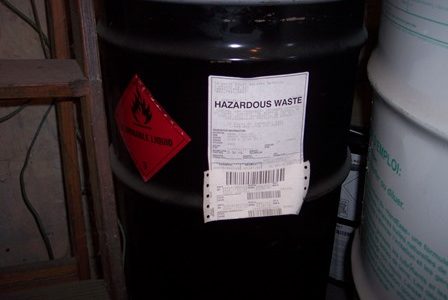Prior to the Generator Improvements Rule the regulations for generators accumulating hazardous waste in a satellite accumulation area (SAA) required containers accumulating hazardous waste to be kept closed except when necessary to add or remove waste. Under the new rule, hazardous waste containers in a SAA may remain open under limited circumstances.
The purpose of this article is to explain the regulations at 40 CFR 262.15(a)(4) that allow for limited exceptions to the closed container requirements in a satellite accumulation area.
Before we begin…
- This is one article in a series that reviews all of the changes made to §262.15 by the Generator Improvements Rule.
- Accumulation of hazardous waste in a SAA is an option for both a large quantity generator of hazardous waste (LQG) and the small quantity generator of hazardous waste (SQG).
- The USEPA Regulations for “Closed Containers” of Hazardous Waste
- FAQ: What is a satellite accumulation area?
- FAQ: What is a central accumulation area?
Scope and Applicability:
- These new regulations were created by the Generator Improvements Rule, which may not yet be adopted by your state. FAQ: What is the status of the Generator Improvements Rule in my state?
- These regulations are applicable solely to the accumulation of hazardous waste in a satellite accumulation area by a LQG or SQG. It does not affect the the requirements for container management at CAAs or interim status treatment, storage, and disposal facilities (TSDFs). USEPA: “At this time, we are not extending this flexibility to containers accumulating in CAAs.”
|
Contact me with any questions you may have about the generation, identification, management, and disposal of hazardous waste Daniels Training Services, Inc. 815.821.1550 |
40 CFR 262.15(a)(4):
(4) A container holding hazardous waste must be closed at all times during accumulation, except:
(i) When adding, removing, or consolidating waste; or
(ii) When temporary venting of a container is necessary
(A) For the proper operation of equipment, or
(B) To prevent dangerous situations, such as build-up of extreme pressure.
What’s it mean?

A container holding hazardous waste in a SAA must be closed at all times during accumulation, except…
A hazardous waste container in a SAA must be closed at all times, except:
- When actively adding, removing, or consolidating waste. Clearly, the container must be opened to perform any of these activities. Once the activity ceases, the requirement for a closed container returns.
Or…
- When temporary venting of a container is necessary for either of two reasons (emphasis added). USEPA relented to state commenters who insisted on the insertion of “temporary” to make it clear that the venting of a container – only for the two reasons described below – is for temporary situations only.
- For proper operation of equipment. USEPA is aware of situations where keeping SAA containers closed can interfere with the operation of equipment when the container is attached directly to the equipment via piping or tubing. The requirement to keep the container closed applies when the equipment is not in operation.
Or…
-
- To prevent dangerous situations. USEPA is aware of situations in which closing a container can be more dangerous than keeping it open temporarily, e.g., when the hazardous waste is very hot. The requirement to keep the container closed applies when the danger passes, e.g., the contents cool.
Q: Is this a loophole to the closed container requirements that I can exploit?
A: No. EPA stresses it does not intend to create a loophole to the closed container requirement or to allow intentional evaporation of hazardous waste.
|
Interested in a Webinar that covers this topic, and more! |
Conclusion:
In the words of the USEPA, the flexibility of this regulation is intended to address the limited cases in which a “strict adherence to the container closure requirements could substantially increase a risk of a hazardous waste incident rather than decrease it.”
The management of hazardous waste in a SAA is not subject to the Hazardous Waste Personnel training requirements for a LQG or SQG. However, if you manage hazardous waste in a CAA, the training requirements of USEPA – and your state – will apply. Contact me to provide the training you need to maintain compliance.
